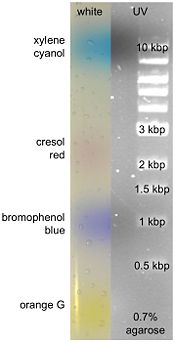Procedure
Measuring nucleic acid concentration in a spectrophotometer
Pipette your nucleic acid sample into a cuvette and record an absorbance scan from 240-340 nm.
Most calculations are done from the Abs at 260 nm.
Why scan instead of single-point reading? You want to make sure the 260 value you record is coming from the absorbance of nucleic acid and not from protein dust or phenol or any other junk that may be in your sample.
DNA
Divide the absorbance at 260 nm by 0.02 for dsDNA or 0.027 for ssDNA. This is the “concentration” in μg/mL. To get concentration, you have to know the length of your molecule and use the mass/volume to calculate a concentration.
RNA
ss RNA, Divide by 0.025. There is no good way of calculating a value for folded RNA so see the next entry. You’ll notice that the peak of absorbance for RNA is left at 260, this is normal.
Make your RNA Extinction coefficients
I couldn’t find the extinction coefficient for individual ribosomal subunits, so I did the following.
Use this reference for more info: Cavaluzzi MJ, Borer PN. 2004.
I purified the subunits. Then, I prepared several samples. Each was diluted to the same extent in the final reaction. One “Native” folded form that was in a translation buffer, one “dissociated” in Phosphate and EDTA, and one “hydrolyzed” to get an accurate concentration measurement.
The hydrolyzed sample was prepared by incubating 5 μL of the ribosome with 20 μL of 1.0 N NaOH for 1 hour at 37 degrees. Then I neutralized the sample with 20 μL of 1.0 N HCl. I Added 1 mL of 100 mM NaHXPO4 at pH 7.0 with 1 mM EDTA. (this is the same pH used by Cavaluzzi and Borer).
Measure the absorbance of all three samples. I did mine in triplicate and averaged the final values.
So, use the known extinction coefficients obtained by Cavaluzzi and Borer. Use a word processor to determine the number of nucleotide in your particular RNA and multiply by the extinction coefficient for that nucleotide. Then sum the four values. This will give a “formal” extinction coefficient for your RNA.
Ext. Coeffs at 260;
pA = 15,020
PC = 7,070
pG = 12,808
pU = 9,660
Using the observed A260 for your fully hydrolyzed RNA sample, determine the concentration of your RNA.
Now, with that known concentration and the measured A260 of the native and unfolded samples, generate extinction coefficients for these conditions. In the future, you won’t have to hydrolyze the samples, just dilute them in a buffer and measure.
I calculated the following for E. coli ribosomal subunit RNAs:
Hydrolyzed:
23S = 33,386,832
16S = 17,588,970
5S = 1,318,308
23S + 5S (large subunit) = 34,705,140
In 100mM NaHXPO4 1 mM EDTA:
50S = 25,457,162
30S = 13,646,276
70S = 39,103,438
In 100 mM K+glutamate, 6 mM MgCl2, 20 mM Tris-HEPES pH 7.8, 0.05% Tween-20, 14 mM mercaptoethanol
50S = 27,058,100
30S = 13,394,967
70S = 40,453,067
I usually dilute a ribosome prep 1/500 to 1/1000 in PO4 buffer and measure that because the tween and mercaptoethanol absorb like crazy and make variable baselines.


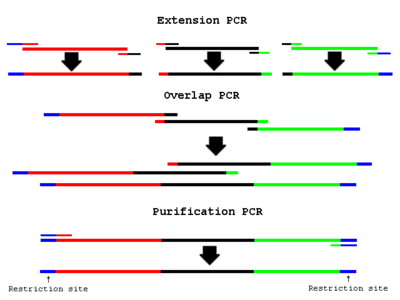
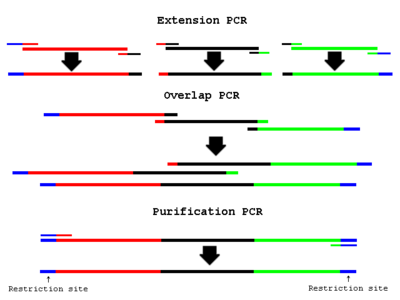

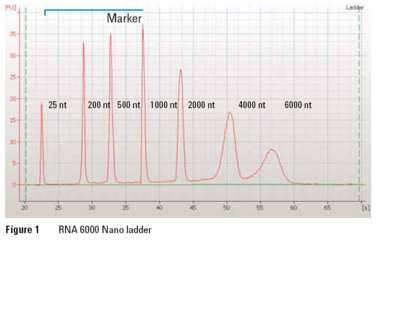

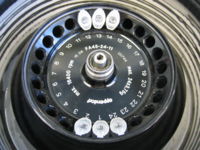
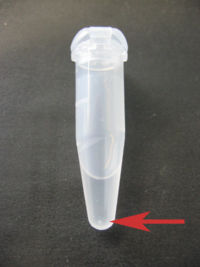
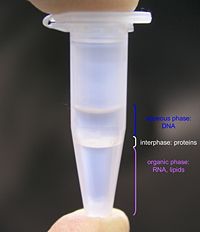 DNA extraction with phenol/chloroform/isoamyl alcohol pH 8 – aqueous top phase contains the majority of DNA, interphase mostly proteins, and lower organic phase most of the RNA and lipids
DNA extraction with phenol/chloroform/isoamyl alcohol pH 8 – aqueous top phase contains the majority of DNA, interphase mostly proteins, and lower organic phase most of the RNA and lipids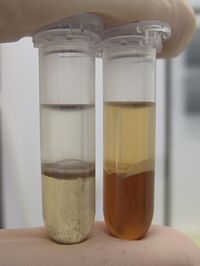 Phenol/chloroform extraction of mostly genomic DNA from different tissue samples. Left: mouse tail sample; right: parallel extraction from mouse liver sample.
Phenol/chloroform extraction of mostly genomic DNA from different tissue samples. Left: mouse tail sample; right: parallel extraction from mouse liver sample.